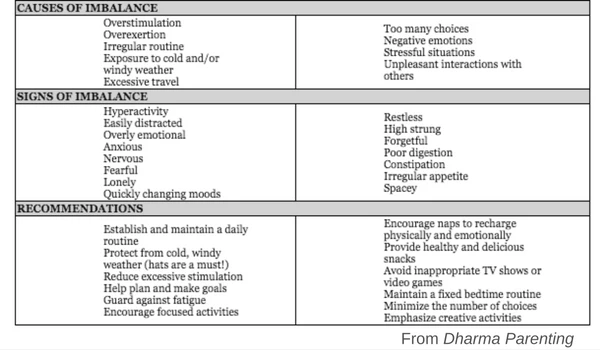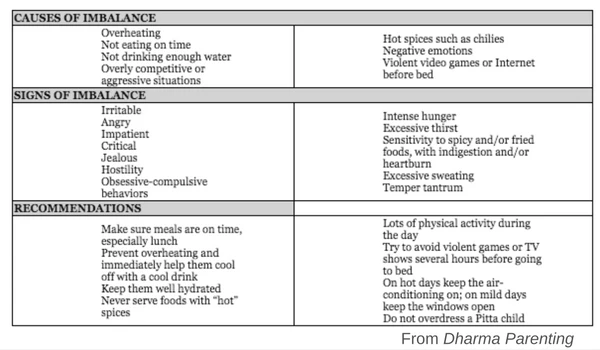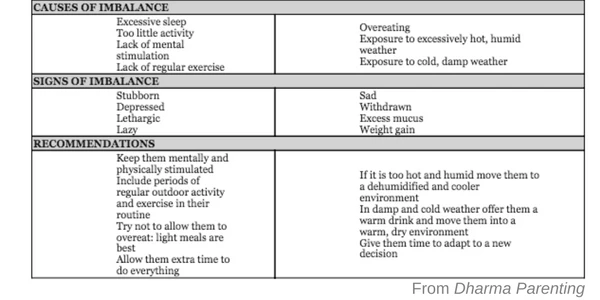What Is Your Child’s Brain/Body Type?

Do you ever wish you just had a manual to help you understand your child? As a mother, sometimes I wonder how my child could possibly be from the same genetic pool as myself. At times my daughter is just so different from who I am that I have trouble understanding her needs, and how to best pacify her.
Many parents run into this very same problem because the mini-me’s have their own unique personalities. Luckily there is a very ancient tool that can come in handy in helping us out. Meet Ayurveda by way of the new book Dharma Parenting.
Scientists and sociologists have identified many different types of people through emotional needs, IQ, low or high attachment, and of course the classic types of “easy” or “challenging” personalities when children are just babies. Although sometimes, it feel likes every mother thinks their fussy babies are the “challenging” ones!
In Ayurveda, India’s ancient healing modality, there are also different categories of people who have different constitutions, mental makeups, and physiological characteristics. And according, to Dr. Keith Wallace, one of the authors of Dharma Parenting, it is because sometimes children and parents do not belong to the same category that understanding can prove to be difficult.
There are three main types of people according to Ayurveda, and they all act in a unique way. At any point in the day, your little one can be in balance, or out of balance, with the elements. Understanding what triggers them can help you understand what they are experiencing and how you can help them with their reactions to be more happy and successful.
Here are three brain/body types of Ayurveda and how best to understand these personalities.
Vata
Children of this type are very sensitive, always changing, and highly creative. They do everything fast: talk fast, walk fast, eat fast, they are going a million miles a minute. They are very energetic, but they are not marathon runners; rather they are sprinters, with short bursts of energy that need to be managed. Their energy and moods are constantly in flux. Dr. Wallace says, Vatas are compared to the wind—moving, cool, light, and dry.
Body: Physically, vata types tend to be tall and on the thin side, or they can be small and delicate framed. Like the wind, they are cold so their hands and feet are usually cool to the touch. As a parent you have to take extra care to keep them warm. Make sure they have a winter hat and gloves on when its even just a little bit chilly outside because they get sick very easily with the first bite of cold weather.
Disposition: Their beautifully imaginative minds are always going like the energizer bunny and can easily become restless. They are enthusiastic, flexible, love change and discovering new things. In general, they are also quick to learn—but also quick to forget! Their attention is constantly moving with shiny object syndrome, so as a parent it’s important to help them reign in and be focused.
Even as vata children grow into teenage years, their energy levels and mood can change rapidly from active and happy to suddenly feeling exhausted and imbalanced. When they are young, teach them to monitor their energy levels by checking in regularly and taking rest breaks to prevent a crash.
Vatas love variety but having too many choices can leave them scatterbrained, so limit choices. They tend to be impulsive and change their minds frequently. Keep things simple and don’t offer too many choices. However, your sensitive vata child naturally has definite likes and dislikes, so go with the flow of their discerning nature.
Vatas by nature are highly sensitive to all stimuli, which makes them natural artists. This coupled with their lithe bodies gives them an edge in dance and gymnastics. When vata children are young its helpful to always keep art supplies like crayons, colored papers, pretty stones, glue and feathers around for creative play, as opposed to having another iPad session or playing with battery-operated toys.
Vata children in balance are euphoric and love to engage in creativity through singing, dancing, and creating art. But when they are out of balance, they can be high strung, nervous, and fearful. Movies or video games that are violent or high energy can be too stimulating for these sensitive kids. Avoid them altogether if possible, or at least keep them to a minimum and not too close to bedtime.
Dr. Wallace notes that these children are gifted with verbal skills and as babies are early talkers and the first teens to get on the texting bandwagon. You have to be especially careful to make sure they understand that texting and driving don’t mix.
Food: Have you ever tried to cook breakfast over a campfire while its windy? The fire is hot but not steady. Maybe you can make s’mores or fry a quick egg but it’s impossible to make a pot of oatmeal or a stew. Vatas are easily imbalanced by too much wind, which interferes with the digestive fire or agni, leading to digestive problems. Their hunger is also irregular. Sometimes they’re hungry, sometimes not. Sometimes they want to eat a little bit, sometimes a lot, and other times not at all.
They do best with eating smaller meals throughout the day. Eating heavy carb-loaded meals of lasagna or sugary desserts will clog their systems. Because the dryness of the wind can so easily overtake their bodies, constipation and dehydration are also things to look out for. The best remedy for this is lots of water, preferably warm, and staying away from foods that are cold and dry in nature. A vata child can easily get sick, so equilibrate with lots of warm liquids and warm foods, especially in the winter.
Sleep: Having a strong routine can help vatas be less scattered. Aim to have a solid schedule for specific activities like sleep, play, exercise, schoolwork, and meals. Rest is also crucial for these sensitive children, so establish healthy sleep routines with warm baths, a calming story, soft music and soothing aroma oils.
Special Care – Movement: Traveling means a lot of movement, and too much movement can be a cause of imbalance for Vatas. It best to counteract the extra stimulation with nourishing warm liquids and foods, and sticking to their daily routine before and after the trip. Also, having their favorite blanket or toys can provide security and grounding.

Pitta
Pitta is like the summer sun—hot, bright and powerful. They are fire incarnate, which rules digestion, body heat, mental brilliance, physical strength, and temper. They are dynamic and reactive. And often possess sharp intellect and warm emotions.
Body: Physically, pittas usually have medium builds and are physically strong and resilient. It’s cliché but these children tend to have reddish hair, skin, and freckles. They have lots of energy and focus, which make them good athletes. Actually, they require lots of physical activity to absorb all their energy!
Disposition: Pittas are problem solvers, goal oriented and decisive. They are perfectionists and reluctant to learn to speak as quickly as vatas. They wait until they are sure. But when they start to talk, they amaze everyone around them with their ideas expressed in clear, strong language.
When they start school, their stories are far ahead of their age group. School in general comes easily to them as long as their teachers keep their bright intellects engaged and challenged. They love to test ingenuity, and stay focused until they figure it all out. The best games for them are puzzles and mazes as opposed to coloring books which their vata peers love.
Dr. Wallace writes, Pittas are also natural leaders and highly competitive in school and sports but their focus on winning can turn into fiery aggression. If a pitta kid is unbalanced, then they will become demanding and want control because they think they know better than everyone else. Their Achilles heel is that their brain and psychology can quickly become agitated by two simple things: overheating and not eating on time.
Food: These kids have strong digestion and healthy appetites. They need to eat ample meals and on time. Missed meals means impatience and irritability is on the horizon. Since noon is when digestive power is at peak, it’s ideal to give them lunch as close to noon as possible. Be sure to pack plenty of snacks, and cooling drinks especially if you are out running errands to avoid temper tantrums in the middle of a store. Also, pitta types love spicy foods but these are heat causing and will aggravate their constitution so its best to avoid them altogether.
Sleep: As toddlers, this group gives up their naps before other kids—the world is just so fascinating, who wants to sleep in the middle of the day! Don’t worry they will make up this time at night by sleeping deeper and longer at night. At daycare, if naptime is mandatory, this time can be spent with books or puzzles.
Usually pittas fall asleep easily at night, but sometimes they want to figure out how the entire universe works before they close their eyes and can’t fall asleep, or get up in the middle of the night to solve the problem. A solution is to tell them a long, involved, and tedious bedtime story in which almost nothing happens. This captures their attention but gives their lively minds nothing to engage with. Also its best to stop intense TV shows, games, or homework too close to bedtime.
Special attention – Heat: It cannot be emphasized enough that pittas are sensitive to heat—spicy food, intense environments, and summer months.
They don’t like sweaters and love the air-conditioning. When it’s hot outside, make sure to keep them in shaded areas and with appropriate gear of sunglasses, hats, and sunblock to protect their sun-sensitive pitta eyes and skin. For vigorous but cooling exercises try swimming and skiing. Make sure to keep them hydrated to prevent overheating!

Kapha
Kapha embodies solidity— bones and muscles, fat and sinews. Kapha is like the earth in the early spring: cool and moist, solid, and a bit heavy. These kids are steady and strong, physically, mentally, and emotionally. Dr. Wallace writes, they have the sweetness of spring, and like spring, they can be slow to get going. But you can count on them to show up eventually.
Body: Physically, kaphas have a sturdy build, are strong, have excellent stamina, and enjoy lots of physical activity. Once you get them going—which can sometimes be a challenge—they embody Newton’s First Law: A body at rest tends to stay at rest. A body in motion stays in motion. But a kapha child needs physical activity or they will become sluggish.
Be sure to always incorporate regular exercise, preferably outdoors, into their routine either at home or through team sports. With their immense stamina and strength, they are best at soccer, basketball and wrestling. If vatas are bothered by the cold, dry weather, and pittas are bothered by the heat, then what about kaphas? They do terrible in humidity and dampness. Help them stay balanced with a dehumidifier in the summer and hot tea in the winter.
Disposition: A well-balanced kapha is steady as a rock. But on the flip side, this steadiness can slow them down because they are deliberate and methodical about all their actions. They take longer than most kids to put on socks, shoes and to leave the house. As a parent, understand this is their nature and be patient and plan ahead.
They need to carefully think through their decisions, so go over things slowly, giving them ample time to scrutinize everything carefully. Just like with vatas, its best to limit their choices, but for different reasons. Once kaphas make a decision, they are immovable. It will take a charging elephant to change their minds!
They learn best by doing rather than listening. Give them activities to explore new concepts or allow them to write about it. Just be sure to explain steps one at a time. Unlike pittas, they won’t remember the instructions easily, but once they learn it, they are the least likely to forget.
According to Dr. Wallace, these kids are loyal, patient, thoughtful, compassionate, and easy going. It’s rare to find them angry or frustrated. When everyone is getting stressed or anxious, they are stable and maintain their sense of humor. They are often the ones who can keep their heads in an emergency and the one everyone comes to depend on when things become tough.
However, if they are too sedentary they can become withdrawn and depressed. And once out of balance, they won’t do anything that requires effort, which spirals into states of lethargy. Keep them stimulated and physically active. Lighten things up by adding fresh fruit and veggies to the diet and engaged in social activities.
Food: Kaphas have strong appetites, but unlike pittas they can eat late or miss a meal without any problems. They are foodies and can easily overeat which exacerbates their slow metabolism and causes weight gain. If they overload with heavy, fried foods and sweets they can easily get congested with a stuffy nose and a wet cough. Encourage them to eat lighter foods like wraps instead of burgers, or chocolate dipped strawberries instead of chocolate cake.
Sleep: As toddlers, they take longer to grow out of naps. Sleep is kapha’s best friend and they fall asleep easily and have a far better chance of sleeping throughout the night at an early age then the other types. The only problem is getting them going in the morning. A useful technique is to appeal to there foodie senses by describing breakfast waiting for them, or invite them into the kitchen to prepare treats.
Special care – Obsession: When out balance, kaphas can become obsessive because they don’t want change. They want the same person, toy, or clothes to be with them always. Dr. Wallace suggests that during this time you have to create a stable, predictable routine. Give them plenty of time to adjust to change.
For example, if you are planning a Thanksgiving trip, make it concrete by showing pictures of the place and people that will be there ahead of time. Your kapha child and you will do great as long as you remember they require a little extra motivation and stimulation at times—and then they are the sweetest of the bunch!

Want to learn more about your child’s brain/body type (or your own)? Click on the link below to take a quiz!
Study with YogaUOnline and Sue Elkind: Prenatal Yoga Essentials for a Healthy Pregnancy & Birth.
Read more about Ayurveda and Integrative Medicine programs: New Online Master of Science In Ayurveda and Integrative Medicine Launched.

Supriya Venkatesan is a freelance writer based in Princeton, NJ. She has written for Forbes, The Washington Post, TIME, Huffington Post, and elsewhere. She holds a MS in Strategic Communications from Columbia University and a BA in Media & Communications from Maharishi University. When not wiring articles, or writing for her memoir based on her military deployment to Iraq, you can find her engrossed in meditation or chasing her toddler.

Dr. Robert Keith Wallace received his Ph.D. in Physiology from the University of California at Los Angeles and did his postdoctoral research at Harvard Medical School. His seminal papers published  in Science, the American Journal of Physiology, and Scientific American, showed that Transcendental Meditation technique produced a fourth major state of consciousness different than waking, sleeping, or dreaming. Dr. Wallace was the founding President of Maharishi University of Management and established the first Maharishi AyurVeda Clinics in the United States.
in Science, the American Journal of Physiology, and Scientific American, showed that Transcendental Meditation technique produced a fourth major state of consciousness different than waking, sleeping, or dreaming. Dr. Wallace was the founding President of Maharishi University of Management and established the first Maharishi AyurVeda Clinics in the United States.
 Dr. Frederick Travis is Professor of Maharishi Vedic Science, Chair of the Department of Maharishi Vedic Science, Dean of the Graduate School, and Director of the Center for Brain, Consciousness, and Cognition. He earned an MS and PhD in Psychology from Maharishi University of Management, and a BS in Design and Environmental Analysis from Cornell University.
Dr. Frederick Travis is Professor of Maharishi Vedic Science, Chair of the Department of Maharishi Vedic Science, Dean of the Graduate School, and Director of the Center for Brain, Consciousness, and Cognition. He earned an MS and PhD in Psychology from Maharishi University of Management, and a BS in Design and Environmental Analysis from Cornell University.




